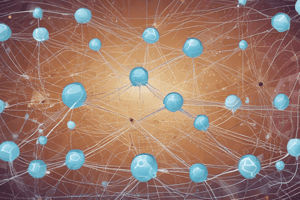Podcast
Questions and Answers
Was ist die Hauptfunktion der Stau- und Flusskontrolle in einem Netzwerk?
Was ist die Hauptfunktion der Stau- und Flusskontrolle in einem Netzwerk?
- Optimierung der WLAN-Signalstärke im Netzwerk
- Überwachung der Softwareaktualisierungen im Netzwerk
- Verwaltung des Datenverkehrs zwischen Sender und Empfänger (correct)
- Verwaltung der physischen Sicherheit von Netzwerkknoten
Was bezeichnet in einem Netzwerk den Prozess, der für die Minimierung von Datenverlusten und die Aufrechterhaltung der Netzwerkleistung verantwortlich ist?
Was bezeichnet in einem Netzwerk den Prozess, der für die Minimierung von Datenverlusten und die Aufrechterhaltung der Netzwerkleistung verantwortlich ist?
- Buffermanagement (correct)
- DNS-Namensauflösung
- Bit-Rate-Kontrolle
- Ossification
Welche Rolle spielen neue Protokolle und Technologien in Bezug auf Netzwerkanforderungen?
Welche Rolle spielen neue Protokolle und Technologien in Bezug auf Netzwerkanforderungen?
- Störung der Signalübertragung in drahtlosen Netzwerken
- Beschleunigung der physischen Verbindungen in LANs
- Erhöhung der Sicherheit von Personal Area Networks (PANs)
- Bereitstellung von Lösungen für spezifische Netzwerkanforderungen (correct)
Was beschreibt den Prozess, bei dem digitale Signale in ein physisches Netzwerk umgewandelt werden?
Was beschreibt den Prozess, bei dem digitale Signale in ein physisches Netzwerk umgewandelt werden?
Was ist die Hauptfunktion des Domain Name Systems (DNS) in einem Netzwerk?
Was ist die Hauptfunktion des Domain Name Systems (DNS) in einem Netzwerk?
Was bezeichnet den Prozess der Verhärtung oder Stabilisierung eines Netzwerkprotokolls im Laufe der Zeit?
Was bezeichnet den Prozess der Verhärtung oder Stabilisierung eines Netzwerkprotokolls im Laufe der Zeit?
Was ist das Ziel von Multiprotocol Label Switching (MPLS), Quality of Service (QoS) Mechanismen und Software Defined Networking (SDN)?
Was ist das Ziel von Multiprotocol Label Switching (MPLS), Quality of Service (QoS) Mechanismen und Software Defined Networking (SDN)?
Welche Rolle spielt das Domain Name System (DNS) bei der Internetnavigation?
Welche Rolle spielt das Domain Name System (DNS) bei der Internetnavigation?
Was ist der zentrale Aspekt der Übertragung von Daten in Computernetzwerken?
Was ist der zentrale Aspekt der Übertragung von Daten in Computernetzwerken?
Was ist Routing im Kontext von Computernetzwerken?
Was ist Routing im Kontext von Computernetzwerken?
Welche Bedeutung hat das Encoding im Zusammenhang mit Bits und Signalen in Computernetzwerken?
Welche Bedeutung hat das Encoding im Zusammenhang mit Bits und Signalen in Computernetzwerken?
Welche Algorithmen werden häufig für die Bestimmung der effizientesten Route in Computernetzwerken verwendet?
Welche Algorithmen werden häufig für die Bestimmung der effizientesten Route in Computernetzwerken verwendet?
Flashcards are hidden until you start studying
Study Notes
Computing Networks: Fundamentals and Modern Developments
Computer networking enables the exchange and sharing of data and resources among two or more interconnected devices. It encompasses a range of topics, including various types, networking protocols, and security considerations. In this article, we delve deeper into the subject matter, exploring the foundational concepts, recent developments, and emerging trends.
-
Network Types: A computer network can be classified based on its geographical coverage and topology. Common examples include Local Area Networks (LANs), Wireless Local Area Networks (WLANs), Wide Area Networks (WANs), Metropolitan Area Networks (MANs), and Personal Area Networks (PANs). Each type offers distinct advantages in terms of coverage, scalability, and management.
-
Network Controlling Techniques: Two primary methods regulate the flow of data within networks – Flow Control and Buffer Management. Flow control is responsible for managing traffic congestion between sender and receiver, ensuring the sender does not overwhelm the receiver with too much data. Buffer management, on the other hand, maintains an intermediate storage system to minimize data loss and maintain network performance.
-
New Protocols and Technologies: Over the years, various protocols and technologies have emerged to address specific network requirements. Examples include Multiprotocol Label Switching (MPLS), Quality of Service (QoS) mechanisms, and Software Defined Networking (SDN). These innovations aim to improve network performance, security, and adaptability.
-
Bits and Signals: At the heart of computer networking lies the transmission of binary digits (bits) as signals. Various encoding methods, such as Manchester Encoding, are employed to represent binary data in electrical or magnetic signals. These signals travel via cables or airwaves to reach their intended destination.
-
Domain Name System (DNS): The Domain Name System plays a crucial role in translating human-readable domain names into machine-friendly IP addresses. By mapping www.example.com to 192.168.1.1, for instance, DNS allows seamless navigation across the internet.
-
Routing: Routing is the process of selecting paths for data packets to traverse between source and destination. Algorithms like Bellman-Ford and Dijkstra's Shortest Path are commonly used to determine the most efficient route, considering factors such as network topology and link capacity.
These topics are essential for anyone interested in understanding the fundamentals and advancements in computer networking. From establishing basic network configurations to implementing cutting-edge strategies, a comprehensive grasp of these concepts is key to navigating today's digital landscape successfully.
Studying That Suits You
Use AI to generate personalized quizzes and flashcards to suit your learning preferences.




